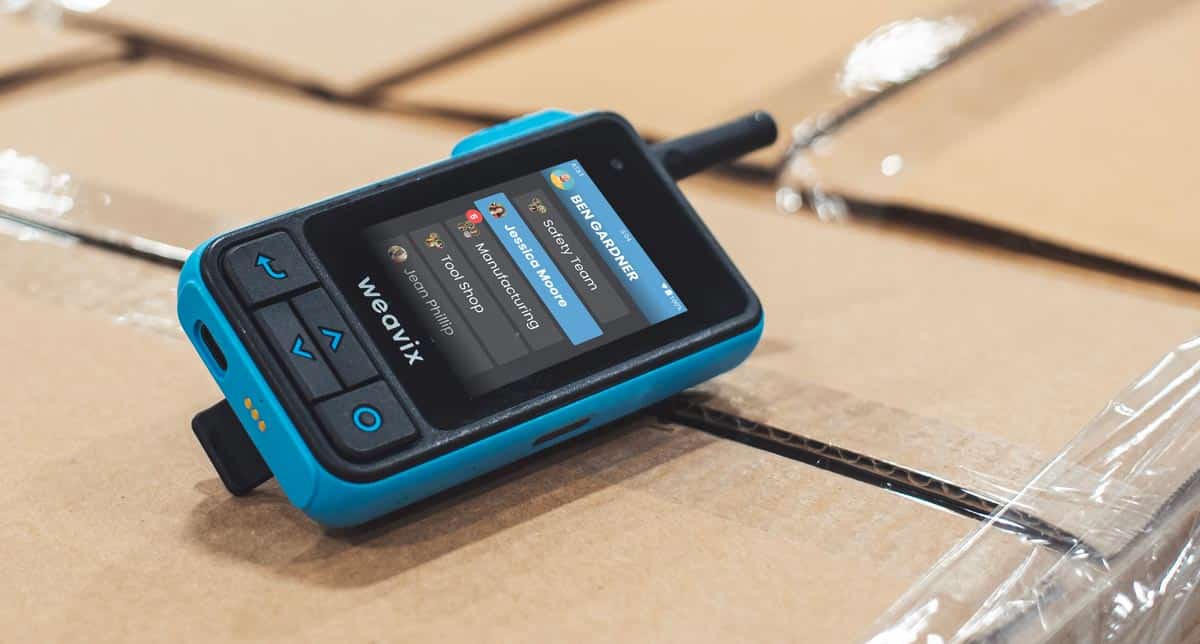These aren’t minor incidents. When approximately 80-90% of workplace incidents are derived from human factors, and smartphone distraction is a growing contributor to that statistic, the stakes couldn’t be higher. OSHA has highlighted distraction as a key factor in workplace accidents, urging industries to adopt stricter guidelines on mobile device use.
Key Highlights:
- Smartphone distractions cause 80–90% of human-factor incidents, making them a growing workplace safety concern, with OSHA warning against mobile use in hazardous environments.
- Microsoft Teams on smartphones fails industrial workers due to slow response times, connectivity issues, and high distraction rates—26% of accidents in industrial settings are linked to smartphone use.
- Smart radios outperform smartphones, offering instant push-to-talk communication, offline reliability, multilingual translation, and built-in safety alerts for faster, safer operations.
- Purpose-built industrial communication systems reduce costs, improve safety, and ensure compliance, outperforming consumer smartphones that fail under rugged conditions.
Manufacturing leaders face a critical decision: should they extend their Microsoft Teams deployment from the office to the factory floor via smartphones? The answer, backed by industry research and safety data, is a resounding no. Here’s why forcing office-centric communication tools onto frontline workers creates more problems than it solves.
The Safety Crisis Hidden in Plain Sight
With over 80% of construction workers owning smartphones, the line between being connected and dangerously distracted has never been thinner. Recent industry research reveals a troubling trend that should concern every plant manager. In industrial settings, 26% of respondents reported workplace accidents caused by smartphone distractions – nearly double the 14% rate seen across all industries. Even more alarming, 75% of distractions in industrial settings led to property damage, while over half (58%) resulted in injury or even death.
This isn’t just about personal safety – it’s about everyone on site. A worker distracted by a Teams notification might not notice a moving crane or overhead hazard, leading to catastrophic results that ripple through the entire operation.
These aren’t minor incidents. When 80-90% of incidents are derived from human factors, and smartphone distraction is a growing contributor to that statistic, the stakes couldn’t be higher. OSHA has highlighted distraction as a key factor in workplace accidents, urging industries to adopt stricter guidelines on mobile device use. With smartphone ownership now omnipresent across industrial workforces, poor communication and ineffective safety systems are directly linked to workplace disasters, with the International Labor Organization reporting nearly 2.78 million annual fatalities globally.
By the Numbers: Why Walt Smart Radio Wins Over Microsoft Teams PTT for Frontline Workers
| Method | Lag Time | Safety Risk | Ruggedness | Battery Life | Hands Free | Ease of Use |
|---|---|---|---|---|---|---|
| Teams Smartphone | 2-8 sec | High | Consumer | 8-12 hrs | No | Complex* |
| Smart Radio | <1 sec | Low | Industrial | 12-16 hrs | Yes | Simple |
| Traditional PTT | <0.3 sec | Low | Industrial | 16+ hrs | Yes | Very simple |
When Every Second Counts, Smartphones Slow You Down
Picture this scenario: A hydraulic leak threatens electrical equipment in your facility. Your maintenance supervisor needs to alert the entire team immediately. With Teams on a smartphone, they must unlock the device, navigate through notifications, find the right chat group, and hope everyone sees the message. This process takes 15-30 seconds in ideal conditions.
Compare this to push-to-talk radios that deliver critical messages in under two seconds. In emergency situations where cascading equipment failures can occur within minutes, that delay isn’t just inconvenient – it’s potentially catastrophic.
The problem goes beyond speed. Survey data shows that the average employee spends 2.5 hours each workday accessing digital content unrelated to their job, creating constant distraction in environments where focus is literally a matter of life and death. The goal isn’t to eliminate technology, but to minimize its chaotic potential in high-risk settings.
The Hidden Costs of Consumer Hardware
The financial reality of deploying smartphones in industrial settings is sobering. Consumer smartphones aren’t built for manufacturing punishment, and the failure rates prove it. Samsung phones showed a 27.4% failure rate, while iPhone 6 models had a 22% failure rate under normal consumer use – conditions far gentler than industrial environments.
Smartphone replacement cycles have shortened to less than two years on average, and that’s in office environments. In industrial settings with dust, moisture, chemicals, and physical shocks, replacement cycles accelerate dramatically. When you factor in:
- Ruggedized cases ($50-150 per device)
- Screen protectors and additional protection
- Replacement costs for damaged devices
- Productivity loss during device failures
- IT management overhead for lost/stolen devices
The total cost of ownership often exceeds purpose-built industrial communication solutions by 40-60%.
Ergonomic Nightmares and Regulatory Risks
The human cost extends beyond accidents. Industrial workers wearing gloves struggle with touchscreen precision. Looking down at small screens while walking increases trip hazards. Extended smartphone use leads to “tech neck” and repetitive strain injuries.
OSHA regulations already forbid cell phone use in construction regulations pertaining to cranes and derricks (29 C.F.R. § 1926.1417(d)), and enforcement is expanding. OSHA investigates credible complaints about employers requiring texting while driving or organizing work where texting becomes a practical necessity. Leadership accountability is critical – management must not only enforce device policies but lead by example in prioritizing safety over connectivity.
As safety incidents linked to smartphone distraction increase, expect stricter regulations and higher workers’ compensation rates. Early adopters of smartphone-based communication in industrial settings may find themselves facing compliance issues and legal liability.
Connectivity Reality Check
Industrial facilities are Wi-Fi nightmares. Large manufacturing facilities suffer from poor or obstructed wireless signals due to concrete walls, metal structures, and electromagnetic interference from heavy machinery. Teams requires constant connectivity for real-time messaging and calls.
When connectivity drops:
- Messages queue but don’t deliver immediately
- Video calls freeze or drop entirely
- Workers assume silence means everything is normal
- Critical updates are delayed or lost
Purpose-built industrial communication systems use mesh networking, offline capabilities, and redundant pathways to maintain contact when infrastructure fails. Because in manufacturing, “can you hear me now?” isn’t just annoying – it’s dangerous.
The Microsoft Reality Check
Even Microsoft acknowledges the limitations. Teams Phone studies focus on enterprise and SMB organizations with traditional office environments, not industrial applications. The ROI calculations assume reliable connectivity, desk-based users, and minimal safety risks.
Microsoft Teams Phone limitations include user capacity limits and potential service limitations for specialized use cases. Industrial manufacturing, with its unique safety requirements and harsh environments, clearly falls into the “specialized use case” category where Teams isn’t optimized.
>>>> Learn how the Walt Smart Radio System sets the standard for modern industrial communication.
The Workforce Resistance Factor
Don’t underestimate human factors. While 66% of employees admit to using cellphones at work multiple times daily, industrial workers often have different expectations. Many frontline workers:
- Prefer simple, tactile tools like radios
- Resist using personal devices for work communications
- Lack familiarity with enterprise applications
- Work in environments where personal phone policies are already restricted
Forcing Teams adoption without addressing these cultural factors leads to poor adoption, workarounds that bypass safety protocols, and decreased morale.
What Industrial Communication Actually Requires
Leading manufacturers are moving toward purpose-built platforms that deliver:
Instant voice communication – Push-to-talk functionality that works in under one second, even without internet connectivity
Industrial durability – IP67/68 rated devices designed for dust, moisture, and impact resistance
Hands-free operation – Voice commands and bone conduction audio that keep hands and eyes free for work
Safety-first design – Man-down alerts, emergency broadcasts, and automated incident reporting
Seamless multilingual support – Real-time translation for diverse workforces, eliminating language barriers
Offline capabilities – Mesh networking that maintains communication when Wi-Fi fails
Companies making this transition report faster incident response times, fewer safety incidents, and improved operational efficiency.
The Bottom Line: Stop Fighting Your Environment
Microsoft Teams is an excellent collaboration platform – for office workers at desks with reliable internet and minimal safety concerns. Your manufacturing operation isn’t an office. Your workers aren’t knowledge workers. Your communication requirements aren’t the same.
The data is clear: smartphone-based communication in industrial settings increases safety risks, drives up costs, and fails to meet the unique needs of frontline workers. Rather than forcing office tools into industrial environments, smart manufacturers are investing in purpose-built solutions designed for their operational reality.
Your frontline workers keep your operation running safely and efficiently. They deserve communication tools built for their world, not adapted from someone else’s. The productivity gains, safety improvements, and cost savings of industrial-grade communication systems aren’t just measurable – they’re essential for modern manufacturing competitiveness.
It’s time to stop asking your factory floor to work like an office. Give your team the tools they actually need to succeed and stay safe.
>>>See our comprehensive comparison guide to learn why smart radio beats two-way radios, Microsoft Teams, smart phones, flip phones and others claiming to be smart radios for critical use cases in manufacturing. Also check out our Microsoft Teams comparison vs weavix.




